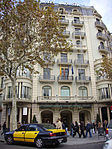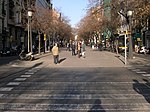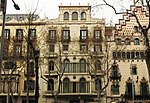Passeig de Gràcia, Barcelona
EixampleModernisme architecture in BarcelonaPasseig de GràciaShopping districts and streets in CataloniaStreets in Barcelona

Passeig de Gràcia (Catalan pronunciation: [pəˈsɛdʒ də ˈgɾasiə]) is one of the major avenues in Barcelona (Catalonia) and one of its most important shopping and business areas, containing several of the city's most celebrated pieces of architecture. It is located in the central part of Eixample, stretching from Plaça Catalunya to Carrer Gran de Gràcia.Passeig de Gràcia is regarded as the most expensive street in Barcelona and in Spain.
Excerpt from the Wikipedia article Passeig de Gràcia, Barcelona (License: CC BY-SA 3.0, Authors, Images).Passeig de Gràcia, Barcelona
Carrer de València, Barcelona
Geographical coordinates (GPS) Address Nearby Places Show on map
Geographical coordinates (GPS)
| Latitude | Longitude |
|---|---|
| N 41.392777777778 ° | E 2.1636111111111 ° |
Address
Rabat
Carrer de València 272
08001 Barcelona
Catalonia, Spain
Open on Google Maps










